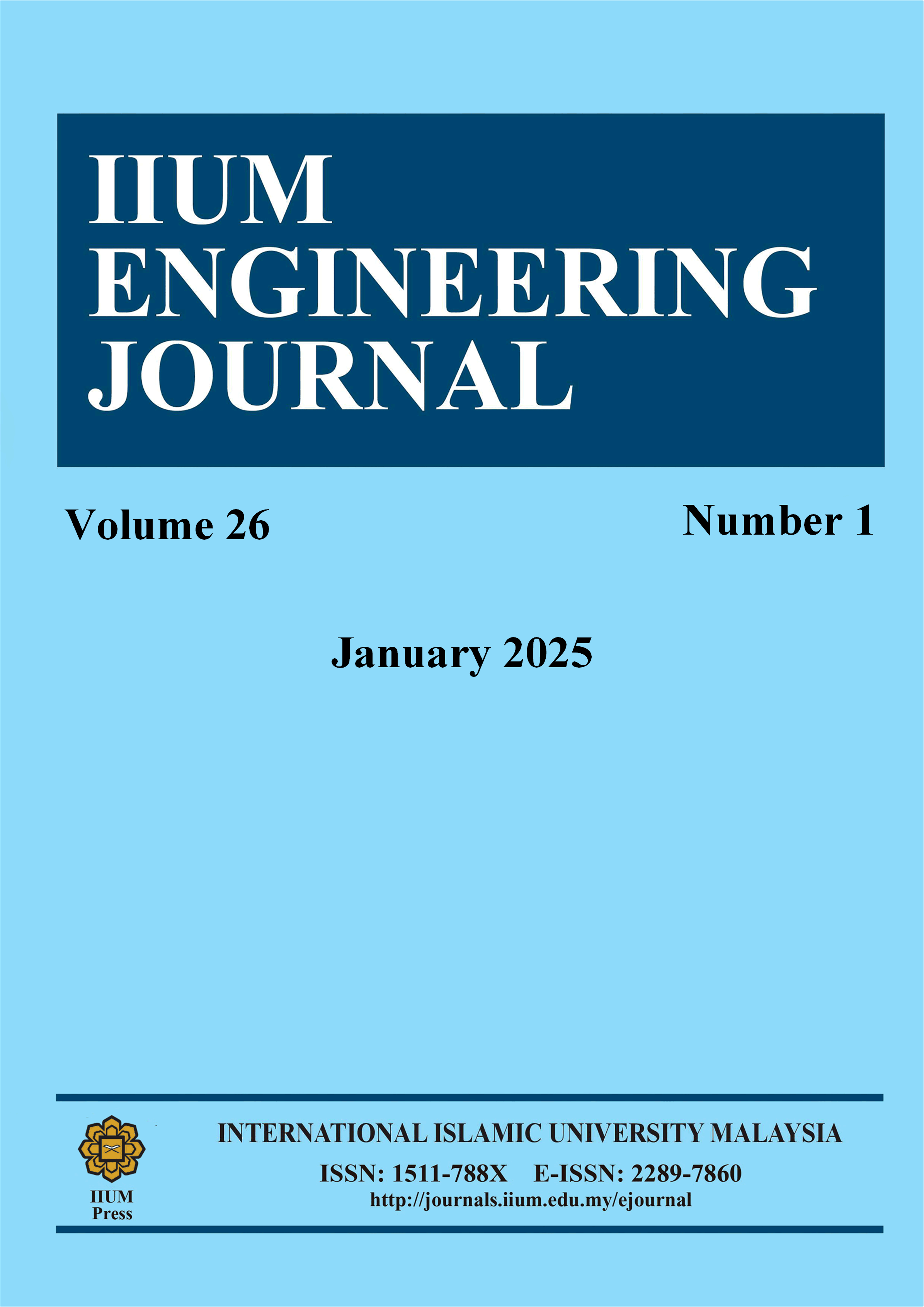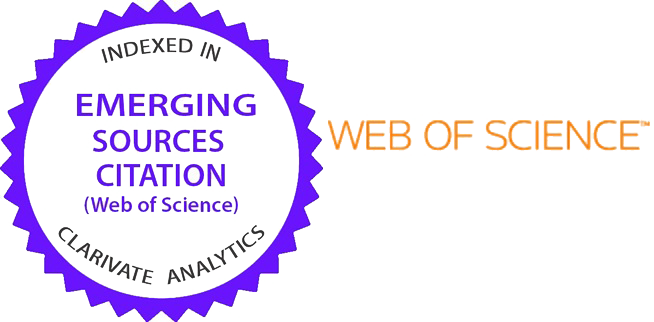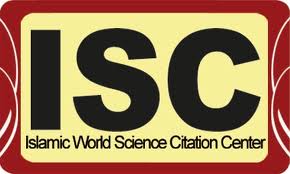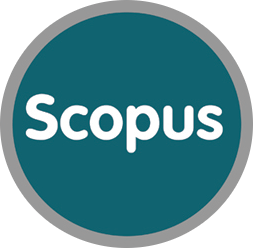Comprehensive Analysis of a Bridged-T Pre-Equalizer Circuit for High-Speed Visible Light Communications
DOI:
https://doi.org/10.31436/iiumej.v26i1.3255Keywords:
Bridged-T circuit, Pre-equalizer, VLC, Scattering parameter, Two-port networks, ADS/MATLABAbstract
This paper presents a comprehensive analysis of a bridged-T equalizer circuit (BTEC) designed for a high-speed visible light communications (VLC) system. The circuit is proposed to overcome the bandwidth limitation of light-emitting diodes (LEDs) in the VLC system. The advanced design system (ADS) and MATLAB were integrated to analyze the behavior of the BTEC in terms of transfer functions and scattering parameters S11, S12, S21, and S22. The results indicate a good correlation between the two tools, with the center frequency being 786 MHz. The 3-dB lower and upper cut-off frequencies are 501 MHz and 1.23 GHz, respectively. The impedance point is at magnitude 1 and 0 phase degrees on the Smith chart. This precise point ensures optimal matching to 50 ? of source and load impedance. This simulation proves that the bridged-T pre-equalizer circuit is a symmetric and reciprocal network since S11 = S22 and S12 = S21. This work combines the computational capabilities of MATLAB with the circuit simulation capabilities of ADS, which satisfied the pre-equalizer circuit experimental stage.
ABSTRAK: Kertas kerja ini membentangkan analisis komprehensif bagi litar penyama T terjepit (BTEC) yang direka untuk sistem komunikasi cahaya nampak (VLC) berkelajuan tinggi. Litar ini dicadangkan untuk mengatasi had lebar jalur diod pemancar cahaya (LED) dalam sistem VLC. Sistem reka bentuk lanjutan (ADS) dan MATLAB telah disepadukan untuk menganalisis kelakuan BTEC dari segi fungsi pemindahan dan parameter serakan S11, S12, S21, dan S22. Keputusan menunjukkan korelasi yang baik antara kedua-dua alat, dengan frekuensi tengah ialah 786 MHz. Frekuensi potong bawah dan atas 3-dB ialah 501 MHz dan 1.23 GHz, masing-masing. Titik impedans adalah pada magnitud 1 dan 0 darjah fasa pada carta Smith. Titik tepat ini memastikan padanan optimum kepada 50 ? sumber dan galangan beban. Dalam simulasi ini, terbukti bahawa litar pra-penyamaan bridged-T adalah rangkaian simetri dan timbal balik sejak S11 = S22 dan S12 = S21. Kerja ini menggabungkan keupayaan pengiraan MATLAB dengan keupayaan simulasi litar ADS, yang memenuhi peringkat percubaan litar pra-penyamaan.
Downloads
Metrics
References
R. Zhang, J. Xiong, M. Li, and L. Lu. (2024) Design and Implementation of Low-Complexity Pre-Equalizer for 1.5 GHz VLC System. IEEE Photonics Journal, vol. 16, pp 1–10. https://doi: 10.1109/JPHOT.2024.3351192. DOI: https://doi.org/10.1109/JPHOT.2024.3351192
X. Li, Z. Ghassemlooy, S. Zvanovec, R. Perez-Jimenez, and P. A. Haigh. (2020) Should Analogue Pre-Equalisers be Avoided in VLC Systems? IEEE Photonics Journal, vol. 12, pp 1–14. https://doi: 10.1109/JPHOT.2020.2966875. DOI: https://doi.org/10.1109/JPHOT.2020.2966875
S. Chaudhary, X. Tang, and X. Wei (2020) Experimental demonstration of 62.5 Mbps VLC link for healthcare infrastructures by incorporating limiting amplifier as an amplification scheme. Microelectronics Journal, vol. 108. https://doi: 10.1016/j.mejo.2020.104971. DOI: https://doi.org/10.1016/j.mejo.2020.104971
A. Thao, X. Kang, and G. H. Lee. (2021) Implementation of an optical wireless communication system deploying a novel post-equalization circuit for indoor application. Microwave Optical Technology Letter, vol. 63, pp 13–18. https://doi: 10.1002/mop.32556. DOI: https://doi.org/10.1002/mop.32556
C. Min et al. (2020) A novel method for constructing VLC equalizer with active-passive hybrid network. IEEE Photonics Journal, vol. 12, no. 2. https://doi: 10.1109/JPHOT.2020.2969413. DOI: https://doi.org/10.1109/JPHOT.2020.2969413
Wei-Ta Huang, Chun-Yen Peng, Hsin Chiang, Yu-Ming Huang, Konthoujam James Singh, Wei-Bin Lee, Chi-Wai Chow, Shih-Chen Chen, and Hao-Chung Kuo. (2022) Toward high-bandwidth yellow-green micro-LEDs utilizing nanoporous distributed Bragg reflectors for visible light communication. Photonics Research, Res. 10, pp 1810-1818. https://doi.org/10.1364/PRJ.462519 DOI: https://doi.org/10.1364/PRJ.462519
Z. Zhang et al. (2019) Over 700 MHz -3 dB Bandwidth UOWC System Based on Blue HV-LED with T-Bridge Pre-Equalizer. IEEE Photonics Journal, vol. 11. https://doi: 10.1109/JPHOT.2019.2910090. DOI: https://doi.org/10.1109/JPHOT.2019.2910090
L. Wang, X. Wang, J. Kang, and C. Patrick Yue. (2021) A 75-Mb/s RGB PAM-4 Visible Light Communication Transceiver System with Pre- and Post-Equalization. Journal of Lightwave Technology, vol. 39, pp 1381–1390. https://doi: 10.1109/JLT.2020.3034227. DOI: https://doi.org/10.1109/JLT.2020.3034227
N. Chi, Y. Zhou, S. Liang, F. Wang, J. Li, and Y. Wang. (2018) Enabling Technologies for High-Speed Visible Light Communication Employing CAP Modulation. Journal of Lightwave Technology, vol. 36, pp 510–518. https://doi: 10.1109/JLT.2017.2783906. DOI: https://doi.org/10.1109/JLT.2017.2783906
D. Yan, X. Mao, S. Xie, J. Cong, and H. Chen. (2019) Design Fully Integrated Driver Circuit for Phosphorescent White Light-Emitting-Diode High Speed Real-Time Wireless Communication. IEEE Photonics Journal, vol. 11, no. 2. https://doi: 10.1109/JPHOT.2019.2904607. DOI: https://doi.org/10.1109/JPHOT.2019.2904607
R. Martinek, L. Danys, and R. Jaros. (2020) Adaptive software defined equalization techniques for indoor visible light communication. Sensors (Switzerland), vol. 20, no. 6. https://doi: 10.3390/s20061618. DOI: https://doi.org/10.3390/s20061618
C. Jin et al. (2022) High-Speed Long-Haul Multi-Channel Nonlinear Optical Communication Systems Influenced by Equalization Enhanced Phase Noise. IEEE 14th International Conference on Advanced Infocomm Technology, pp 103–106. https://doi: 10.1109/ICAIT56197.2022.9862695. DOI: https://doi.org/10.1109/ICAIT56197.2022.9862695
N. Liu, C. Ju, D. Wang, D. Wang, and P. Xie. (2023) Multi-Aperture Coherent Digital Combining Based on Complex-Valued MIMO 2N × 2 Adaptive Equalizer for FSO Communication. Journal of Lightwave Technology, vol. 41, pp 5983–5990. https:// doi: 10.1109/JLT.2023.3276637. DOI: https://doi.org/10.1109/JLT.2023.3276637
D. Silveira, W. Wijekoon, and G. H. Lee. (2018) Demonstration of an optical wireless communication link with pre-emphasis circuit for high-speed application. Microwave Optical Technology Letter, vol. 60, no. 11, pp 2613–2618. https://doi: 10.1002/mop.31491. DOI: https://doi.org/10.1002/mop.31491
X. Huang, J. Shi, J. Li, Y. Wang, and N. Chi. (2015) A Gb/s VLC transmission using hardware preequalization circuit. IEEE Photonics Technology Letters, vol. 27, no. 18, pp 1915–1918. https://doi: 10.1109/LPT.2015.2445781. DOI: https://doi.org/10.1109/LPT.2015.2445781
X. H. Xingxing Huang, S. C. Siyuan Chen, Z. W. Zhixin Wang, Y. W. Yiguang Wang, and N. C. Nan Chi. (2015) 1.2 Gbit/s visible light transmission based on orthogonal frequency-division multiplexing using a phosphorescent white light-emitting diode and a pre-equalization circuit. Chinese Optics Letters, vol. 13, pp 100602–100606. https:// doi: 10.3788/col201513.100602. DOI: https://doi.org/10.3788/COL201513.100602
X. Huang, Z. Wang, J. Shi, Y. Wang, and N. Chi. (2015) 16 Gbit/s phosphorescent white LED based VLC transmission using a cascaded pre-equalization circuit and a differential outputs PIN receiver. Optical Express, vol. 23, no. 17, pp 22034. https:// doi: 10.1364/oe.23.022034. DOI: https://doi.org/10.1364/OE.23.022034
H. Zhang, A. Yang, L. Feng, and P. Guo. (2018) Gb/s Real-Time Visible Light Communication System Based on White LEDs Using T-Bridge Cascaded Pre-Equalization Circuit. IEEE Photonics Journal, vol. 10, no. 2. https:// doi: 10.1109/JPHOT.2018.2812759. DOI: https://doi.org/10.1109/JPHOT.2018.2812759
Y. Wang, X. Chen, and Y. Xu. (2023) Transmitter for 1.9 Gbps phosphor white light visible light communication without a blue filter based on OOK-NRZ modulation. Optical Express, vol. 31, no. 5, pp 7933. https:// doi: 10.1364/oe.476911. DOI: https://doi.org/10.1364/OE.476911
S. H. Hashim and R. Kwok. (2011) Network Techniques: Conversion between Filter Transfer Function and Filter Scattering (S-Matrix) Parameters.
D. A. Frickey. (1999) Conversions between S, Z, Y, H, ABCD, and T parameters which are valid for complex source and load impedances. IEEE Transactions on Microwave Theory and Techniques, vol. 42, pp. 205-211. https:// doi: 10.1109/22.275248. DOI: https://doi.org/10.1109/22.275248
Downloads
Published
How to Cite
Issue
Section
License
Copyright (c) 2025 IIUM Press

This work is licensed under a Creative Commons Attribution-NonCommercial 4.0 International License.
Funding data
-
Ministry of Higher Education, Malaysia
Grant numbers RACER/1/2019/TK04/UIAM//3)






















